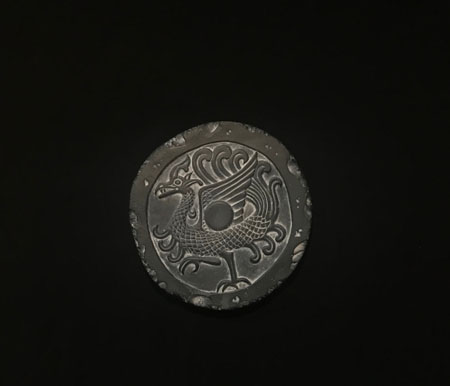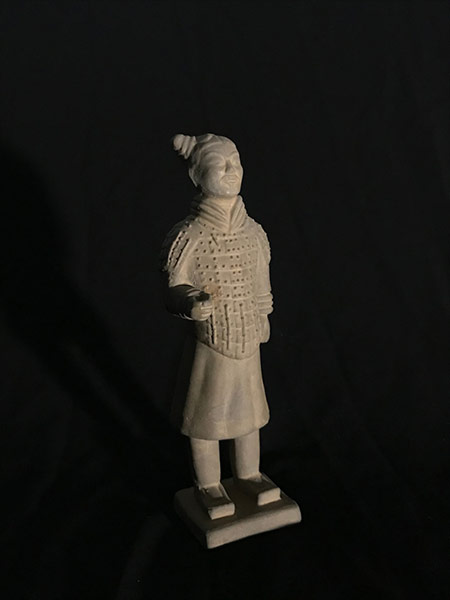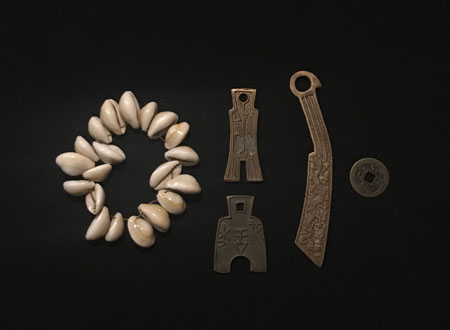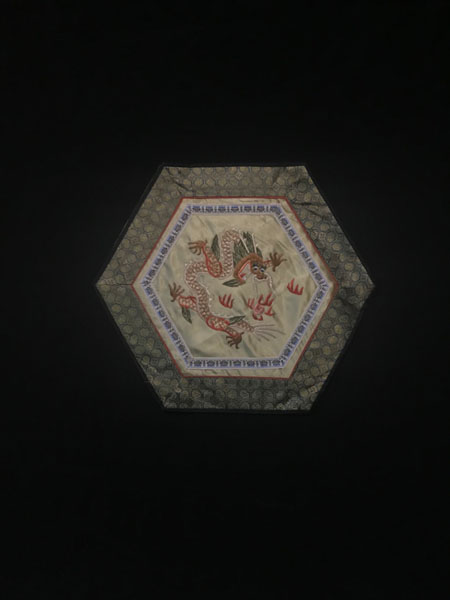Four copies of the Ancient China kit are available for checkout. Each kit is one complete unit, adaptable for grades 3 to 8. Included in the kit are integrated lessons outlined in the teacher's guide, images, and artifacts that have been carefully selected to acquaint students with primary sources. Below are some images and labels about some of the artifacts in this kit.
Han Dragon Facsimile
This is an image of a Dragon from a Chinese clay tile from the Han Dynasty, circa 200 AD. Although it more closely resemble a Griffin, this is a striking example of sculpture from its period. The disk in the center represents the four corners of the universe and the force of life.

Clay Guardian from Xian
Qin Shihuangdi, who unified China in 221 B.C., feared death so much that he regularly left his palace to search for the means to immortality. He consulted sorcerers, made sacrificies to dieties, searched for allegedly magical fungi, and drank what he hoped were life preserving elixirs. When the emperor died in 210 B.C. he was placed in an inner chamber behind a magnificent jade door, which remains sealed to this day. His concubines and those laboreres who knew the way to his burial place were sealed in the tomb with him.
Evacuations of the emperor's "Spirit City," the area surrounding the still-unopened tomb, have revealed what may be the most spectacular tomb in the history of the world. The Spirit City covers at least three acres and was built by 700,000 conscripted laborers, some of whom were scholars and officials who had displeased the king. This 'city' is populated with over 6,000 horses and armed terra-cotta warriors, each one being an individual life-size portrait. These troops of clay were once brightly painted and are cast as archers, cavalry men, and charioteers.

Currency
The barter system was the first system of trade known to man. Strings of cowrie sheels (usually in strings of a thousand) were the first medium of exchange and served as the earliest form of currency in ancient China. These strigns combined the functions of ornament, jewel, and talisman. They originated in the Ch'u, Hubei, and Honan regions.
The spade shaped (pu) coins pictured below were the earliest 'coins', minted in the 5th century B.C. They had replaced the barter and cowrie shells during the Zhou dynasty well before the period of Warring States. The pu was shaped like an iron space and was cast by state mints in gold and copper. The knife shaped coin (tao) were used in the north-eastern regions of Chi, Yen, and Chao. These 'coins' often bear the name of the city in which they were issued. Rich merchants may have been influential in having the 'coins' bear the name of the city of issue.
The circular coin (pictured last on the right) was first circulated in the north-western regions of Chou, Chin, and Chao. Under the Qin emperor Shinhuangdi, a whole series of unifying measures accompanied the division of his territories into thrity-six 'commanderies'. These measures included the creation of one single type of circular copper coin with a square hole in the middle, a pattern which remained in use until our own time.

Embroidered Silk Square
Of all the treasures China harbored behind its sealed borders, none was more mysterious to outsidersand mroe alluring than silk. The secret of cultivating the mulberry silkworm, of unwinding its cocoon which the worms spun every spring, and retrieving its gossamer thread existed in China starting around 5000 B.C. Dyed and woven into cloth, silk served as the mainstay of the Chinese economy, and bolts of silk were used along with gems and gold as currency.

